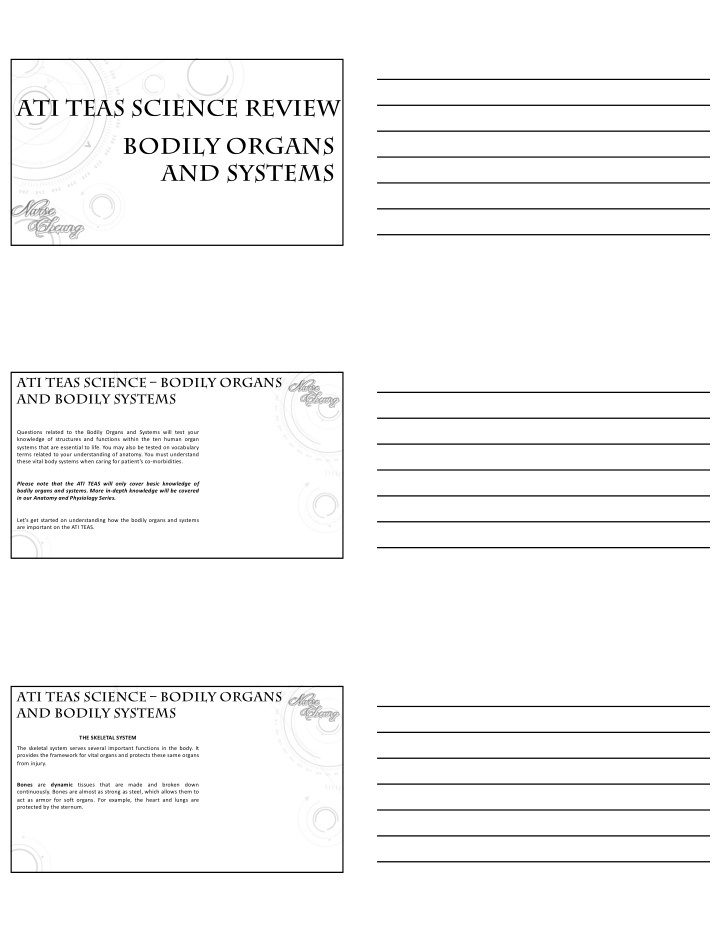



ATI TEAS SCIENCE REVIEW BODILY ORGANS AND SYSTEMS ATI TEAS SCIENCE – BODILY ORGANS AND BODILY SYSTEMS Questions related to the Bodily Organs and Systems will test your knowledge of structures and functions within the ten human organ systems that are essential to life. You may also be tested on vocabulary terms related to your understanding of anatomy. You must understand these vital body systems when caring for patient’s co-morbidities. Please note that the ATI TEAS will only cover basic knowledge of bodily organs and systems. More in-depth knowledge will be covered in our Anatomy and Physiology Series. Let’s get started on understanding how the bodily organs and systems are important on the ATI TEAS. ATI TEAS SCIENCE – BODILY ORGANS AND BODILY SYSTEMS THE SKELETAL SYSTEM The skeletal system serves several important functions in the body. It provides the framework for vital organs and protects these same organs from injury. Bones are dynamic tissues that are made and broken down continuously. Bones are almost as strong as steel, which allows them to act as armor for soft organs. For example, the heart and lungs are protected by the sternum.
ATI TEAS SCIENCE – BODILY ORGANS AND BODILY SYSTEMS THE SKELETAL SYSTEM Bone cells are called osteocytes and there are two main types Osteoblasts (osteo - bone, blasts – form new): cells that make bone • • Osteoclasts (osteo-bone, clasts – break down): cells that break down bone PHOTO CREDIT: NEWS-MEDICAL.NET ATI TEAS SCIENCE – BODILY ORGANS AND BODILY SYSTEMS THE SKELETAL SYSTEM Bone is synthesized within tubular structures called osteons , which are made of hydroxyapatite embedded in a matrix of collagen. Each osteon consists of concentric layers called lamellae , which are compact bone tissue that surround a central canal called the haversian canal , which contains the bone’s blood supply. Photo Credit: U.S. SEER ATI TEAS SCIENCE – BODILY ORGANS AND BODILY SYSTEMS THE SKELETAL SYSTEM There are four types of bones • Long bone has hollow shafts that contain marrow Arm (humerus, radius, and ulna) and Legs (femur, tibia, and • fibula) • Short bone is wider than it is long • Metacarpals and phalanges of the hand, and metatarsals and phalanges in the feet • Flat bone is not hallow, but do contain marrow • Scapula, ribs, and sternum • Irregular bone is a non-symmetrical shaped bone • Vertebral column and patella Photo Credit: Modesto Junior College
ATI TEAS SCIENCE – BODILY ORGANS AND BODILY SYSTEMS THE SKELETAL SYSTEM In total, the body contains 206 bones and are classified into two groups. The axial skeleton contains the skeleton’s center and includes the • skull, vertebral column, and rib cage The appendicular skeleton consists of the arms and legs, also known • as appendages Photo Credit: Medical Dictionary ATI TEAS SCIENCE – BODILY ORGANS AND BODILY SYSTEMS Easy way to remember tendons vs ligaments THE SKELETAL SYSTEM • The T in Tendons stands for Two = Two Another important function of the skeletal system is the interaction types tissue (bone to muscle) between the bone and muscles. Muscles are attached to bones by • The L in Ligaments stands for Lone = One tendons , connective tissue found throughout the body. As muscles type of tissue (bone to bone) contract, tendons pull on the bones and moves certain parts of the body. Photo Credit: Nursing Education Consultants ATI TEAS SCIENCE – BODILY ORGANS AND BODILY SYSTEMS THE SKELETAL SYSTEM There are a few common bone diseases that you should be familiar with. Osteoporosis is caused by loss of minerals from the bone, which • causes its rigidity to be lost. • Osteogenesis imperfecta ( brittle bone disease ) is caused by a genetic defect in the collagen matrix that causes bones to be brittle Photo Credit: Dr. Fuhrman and break easily. Photo Credit: Geisinger.org
Recommend
More recommend